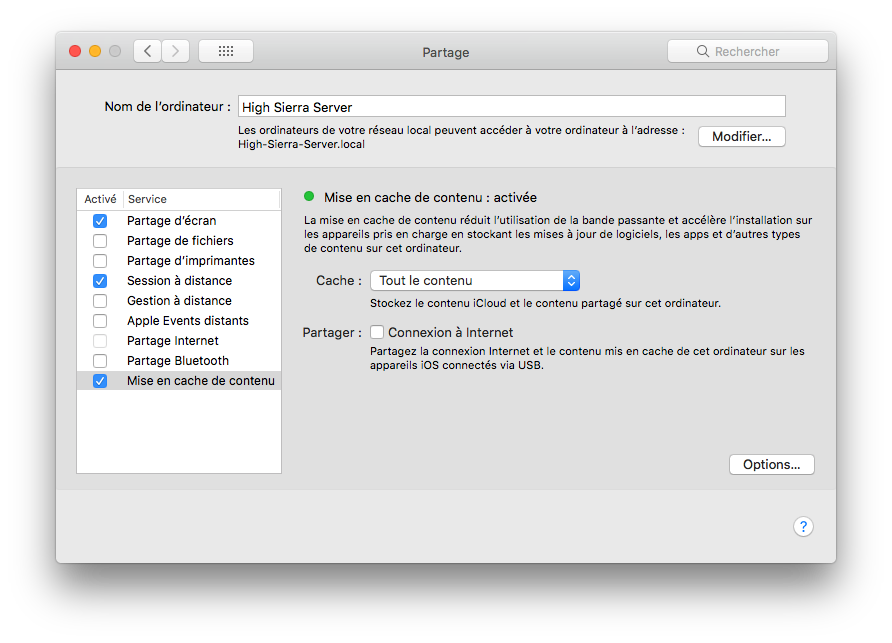

- MAC OS HIGH SIERRA SERVER CACHE PDF
- MAC OS HIGH SIERRA SERVER CACHE UPDATE
- MAC OS HIGH SIERRA SERVER CACHE UPGRADE
- MAC OS HIGH SIERRA SERVER CACHE CODE
Over the past ten years, Apple has moved from a pricy and separate server operating system to an inexpensive app that provides server functionality. That’s a good question, but it’s most likely because Apple feels that the future of services lies in the Cloud, not on local servers. Xcode Server: The functionality of Xcode server is now part of Xcode 9, with Xcode server now being deprecated. From each Mac that needs to be backed up to the server, the user simply points Time Machine to the shared folder using System Preferences > Time Machine. Time Machine: To share a folder for Time Machine backups, you’re now just going to use SMB File Sharing, once again using System Preferences > Sharing to set up the shared folder. Open Directory: Apple has hidden Open Directory on macOS Server 5.4 as it is no longer required for user and group profile management. While it’s possible to use both Server Message Block (SMB) and Apple Filing Protocol (AFP) to share with others, some restrictions will disable sharing over AFP your Mac is using the new Apple File System (APFS) format.

To set up this up, launch System Preferences, then select Sharing > Content Caching.įile Sharing: System Preferences > Sharing is now where all file sharing is configured. This service is now available on any macOS High Sierra machine (see screenshot above), so one Mac on a network can be identified as a caching server for the other devices on that network. Content Caching is now a feature on any Mac running macOS High Sierra

By caching the information on one Mac, which then passes that information on to other devices in the workgroup, bandwidth requirements for updates are reduced.
MAC OS HIGH SIERRA SERVER CACHE UPDATE
Instead, they’ve moved into System Preferences on High Sierra.Ĭaching Service: One of the best features of macOS Server for workgroups with many devices to update and maintain, the Caching Service makes it possible for one Mac to serve as a network cache for iCloud data, app updates, and other Apple-supplied code. As a result, the services are no longer found in the server dashboard. What can you do instead? Consider using WebDAV, or collaboration using the shared document features of Apple’s iWork suite (Pages, Numbers, and Keynote).Īs noted in the lead paragraph, Apple has moved some services out of macOS Server and into the heart of macOS High Sierra. In macOS Server 5.4, iOS File Sharing has removed and any iOS devices that connect to the server report that file sharing has been disabled on the server.

MAC OS HIGH SIERRA SERVER CACHE PDF
Anything placed in the repository became available to designated users, meaning that it was a useful way to share PDF files, documents, templates, and so on. In the previous version of macOS Server, an administrator could set up a shared repository for iOS devices.
MAC OS HIGH SIERRA SERVER CACHE CODE
As a result, upgrading to High Sierra/macOS Server 5.4 removes FTP support.įor organizations that used FTP server as a way to upload media files or website code to a macOS Server, you’ll need to find another way of handling those transfers. Before you consider upgrading any macOS Server to High Sierra and installing version 5.4, it’s important that you know about the changes.įTP has been a mainstay for moving files over the internet since the early days, but apparently Apple feels that it is too much of a security risk in the modern era.
MAC OS HIGH SIERRA SERVER CACHE UPGRADE
While all of the other upgrades added new features and functionality, the macOS Server 5.4 upgrade moved some services into High Sierra and removed other functions that some organizations may find critical. Along with the many other recent operating system upgrades, macOS Server was quietly bumped up to version 5.4 on Sept.


 0 kommentar(er)
0 kommentar(er)
